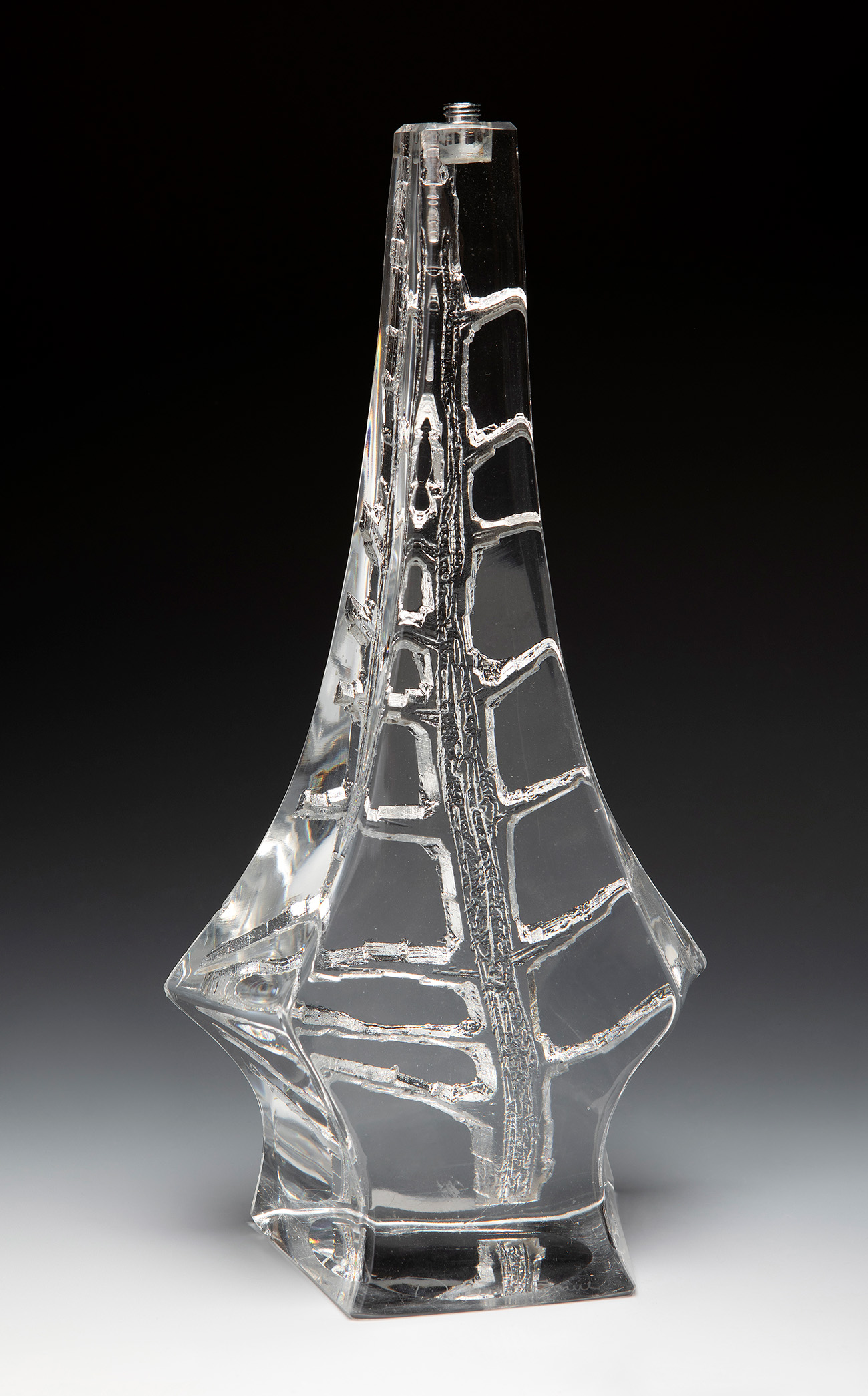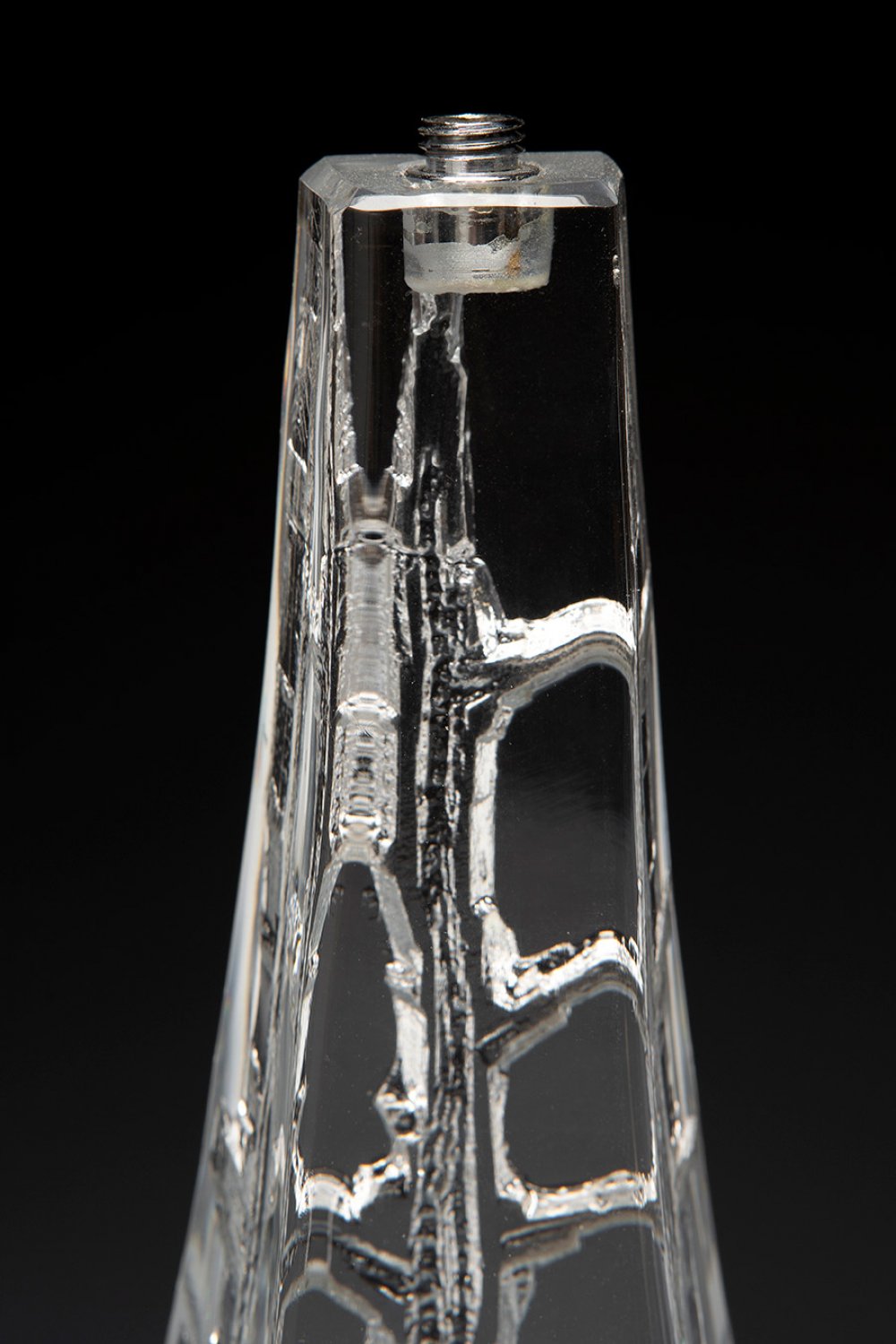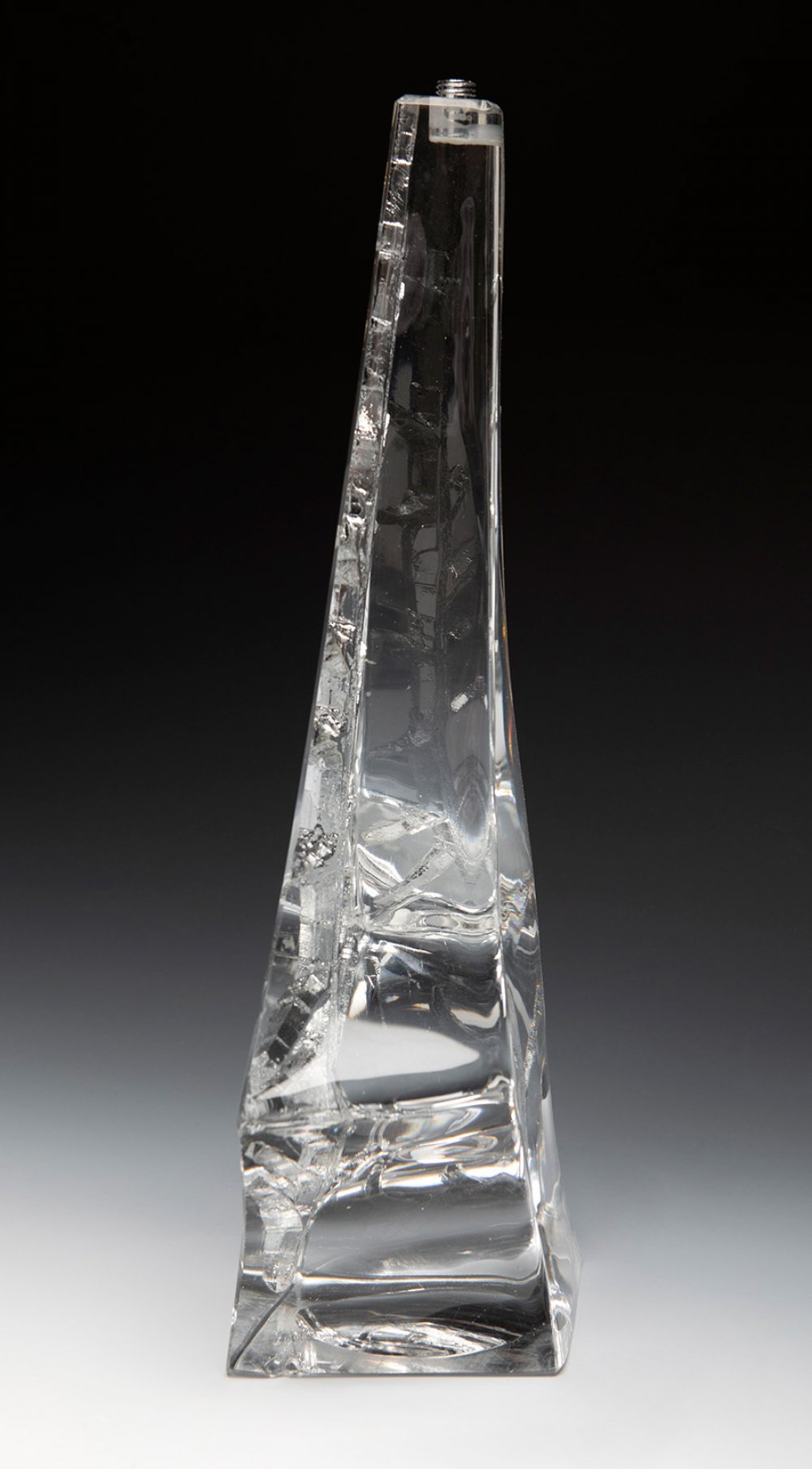17
DAUM. France, ca. 1960.Lamp base "Lynx Lamp".Moulded and cut glass.Signed "Daum France" on the lower
1/5
Description
DAUM. France, ca. 1960.
Lamp base "Lynx Lamp".
Moulded and cut glass.
Signed "Daum France" on the lower back.
There is some chipping at the bottom right and at the base.
Reproduced with photo in "Daum, Mastery of glass, from Art Nouveau to Contemporary Crystal", Noel Daum, p.155.
Measurements: 33 x 17 x 9 cm.
Lamp base in moulded and cut glass, with a quadrangular base and flared body. The lower part has an angular design that fits in perfectly with the scaled ornamentation of the rest of the piece.
The Daum manufacture was founded at the end of the 19th century by Augustin Daum (1853-1909) from a small family glassworks in Nancy. He was joined by his brother Antonin (1864-1931), and the Daum workshops soon became a meeting place and training ground for many young artists, who gave impetus to the Art Nouveau style in Nancy. At first they made ordinary glass, but in 1891 they decided to open a decorative workshop and to embark on artistic production, probably as a result of the success of Émile Gallé (1846-1904) at the 1889 Exhibition. Eventually, Daum had a factory with more than three hundred employees and a wide range of artistic production. During the First World War, the factory closed, but resumed production after the war, adapting to the change in aesthetics and leaving behind the modernism of its first period. During the Art Nouveau period, most of Daum's pieces were made of acid-etched cameo glass, but with the new Art Deco style, new techniques and decorative styles were investigated.
Lamp base "Lynx Lamp".
Moulded and cut glass.
Signed "Daum France" on the lower back.
There is some chipping at the bottom right and at the base.
Reproduced with photo in "Daum, Mastery of glass, from Art Nouveau to Contemporary Crystal", Noel Daum, p.155.
Measurements: 33 x 17 x 9 cm.
Lamp base in moulded and cut glass, with a quadrangular base and flared body. The lower part has an angular design that fits in perfectly with the scaled ornamentation of the rest of the piece.
The Daum manufacture was founded at the end of the 19th century by Augustin Daum (1853-1909) from a small family glassworks in Nancy. He was joined by his brother Antonin (1864-1931), and the Daum workshops soon became a meeting place and training ground for many young artists, who gave impetus to the Art Nouveau style in Nancy. At first they made ordinary glass, but in 1891 they decided to open a decorative workshop and to embark on artistic production, probably as a result of the success of Émile Gallé (1846-1904) at the 1889 Exhibition. Eventually, Daum had a factory with more than three hundred employees and a wide range of artistic production. During the First World War, the factory closed, but resumed production after the war, adapting to the change in aesthetics and leaving behind the modernism of its first period. During the Art Nouveau period, most of Daum's pieces were made of acid-etched cameo glass, but with the new Art Deco style, new techniques and decorative styles were investigated.
Auction Details
Shipping
T&Cs & Important Info
Ask seller a question
DAUM. France, ca. 1960.
Lamp base "Lynx Lamp".
Moulded and cut glass.
Signed "Daum France" on the lower back.
There is some chipping at the bottom right and at the base.
Reproduced with photo in "Daum, Mastery of glass, from Art Nouveau to Contemporary Crystal", Noel Daum, p.155.
Measurements: 33 x 17 x 9 cm.
Lamp base in moulded and cut glass, with a quadrangular base and flared body. The lower part has an angular design that fits in perfectly with the scaled ornamentation of the rest of the piece.
The Daum manufacture was founded at the end of the 19th century by Augustin Daum (1853-1909) from a small family glassworks in Nancy. He was joined by his brother Antonin (1864-1931), and the Daum workshops soon became a meeting place and training ground for many young artists, who gave impetus to the Art Nouveau style in Nancy. At first they made ordinary glass, but in 1891 they decided to open a decorative workshop and to embark on artistic production, probably as a result of the success of Émile Gallé (1846-1904) at the 1889 Exhibition. Eventually, Daum had a factory with more than three hundred employees and a wide range of artistic production. During the First World War, the factory closed, but resumed production after the war, adapting to the change in aesthetics and leaving behind the modernism of its first period. During the Art Nouveau period, most of Daum's pieces were made of acid-etched cameo glass, but with the new Art Deco style, new techniques and decorative styles were investigated.
Lamp base "Lynx Lamp".
Moulded and cut glass.
Signed "Daum France" on the lower back.
There is some chipping at the bottom right and at the base.
Reproduced with photo in "Daum, Mastery of glass, from Art Nouveau to Contemporary Crystal", Noel Daum, p.155.
Measurements: 33 x 17 x 9 cm.
Lamp base in moulded and cut glass, with a quadrangular base and flared body. The lower part has an angular design that fits in perfectly with the scaled ornamentation of the rest of the piece.
The Daum manufacture was founded at the end of the 19th century by Augustin Daum (1853-1909) from a small family glassworks in Nancy. He was joined by his brother Antonin (1864-1931), and the Daum workshops soon became a meeting place and training ground for many young artists, who gave impetus to the Art Nouveau style in Nancy. At first they made ordinary glass, but in 1891 they decided to open a decorative workshop and to embark on artistic production, probably as a result of the success of Émile Gallé (1846-1904) at the 1889 Exhibition. Eventually, Daum had a factory with more than three hundred employees and a wide range of artistic production. During the First World War, the factory closed, but resumed production after the war, adapting to the change in aesthetics and leaving behind the modernism of its first period. During the Art Nouveau period, most of Daum's pieces were made of acid-etched cameo glass, but with the new Art Deco style, new techniques and decorative styles were investigated.
6th of September - Glass & Perfume Collection
Sale Date(s)
Venue Address
Aragón 346, Barcelona
Calle Velázquez 7, Madrid
Carrer de Cirilo Amorós 55, Valencia
Barcelona
08009
Spain
General delivery information available from the auctioneer
Setdart offers Worldwide shipping
PICK UP IN ROOM: You can come and pick up your lots in our offices (Barcelona, Madrid or Valencia). At the moment of the withdrawal, you will be able to accept the current conditions of the lot by means of a document that you will sign.
YOU CAN SEND ANOTHER PERSON TO PICK UP: This person must present a signed authorization that you can find in our web page by accessing from BUY AT SETDART- LOGISTICS-DOWNLOAD AUTHORIZATION DOCUMENT. You can also send an e-mail with the requested data in AUTHORIZATION DOCUMENT to admin@setdart.com
Important Information
25% buyer´s premium
21% buyer´s prmeium at www.setdart.com















